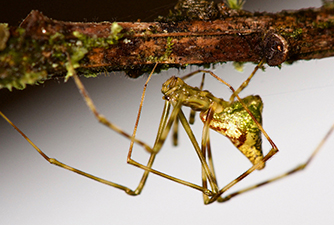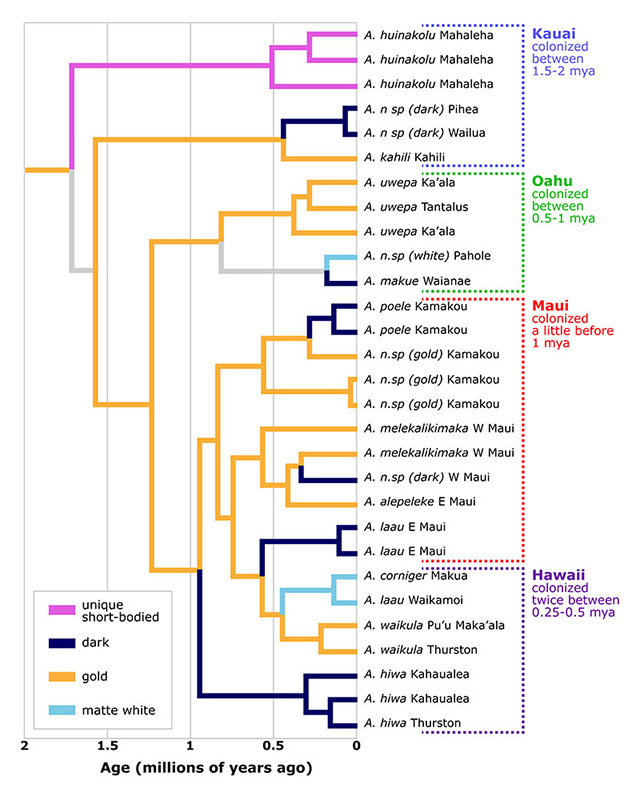
The Hawaiian Islands offer sun-loving tourists a chance to get away from it all in a peaceful paradise, and it is these same qualities that make the islands the perfect place to study evolution. Hawaiian fruit flies, silversword plants, and honeycreeper birds, for example, all offer particularly dramatic examples of the processes of speciation and subsequent adaptation. Last month, biologists added another organism to that list. The ancestor of Hawaiian stick spiders (genus Ariamnes), which have elongated and sometimes sail-shaped abdomens, arrived on Kauai about 1.7 million years ago and proceeded to diversify and evolve in a remarkably predictable manner.
Where's the evolution?
Hawaii is a hotbed of evolutionary study for a few reasons (even beyond the beaches, Mai Tais, and shave ice that are available in between collecting trips!). The current archipelago of volcanic islands has been sequentially rising up out of the Pacific over the last five million years, starting west of Kauai and most recently with the island of Hawaii, which is less than a million years old. Hawaii’s isolation — it’s about as far from other major land masses as it is possible to get — means that immigrants are relatively rare. Furthermore, the scarcity of natural predators makes it a relatively safe haven for any immigrant that does happen to land on these distant lava mounds. Taken together, these traits make Hawaii a tractable study system to reconstruct evolutionary history. Each of the islands forms its own natural experiment, having risen from the ocean as nearly identical blank slates, without vegetation or land animals. Using geological and genetic information, it’s possible to sort out the ages of the islands, as well as when which creatures made it where and when.
The ancestors of the original Ariamnes immigrants were likely spiders that made their living hiding out on the webs of other species and stealing food from the webspinners, but on Hawaii they mainly live off of a web and hunt other spiders at night. Ariamnes arrived on Kauai about 1.7 million years ago, then soon after that on Oahu, then on Maui, and finally on Hawaii. Each island now supports multiple species of Ariamnes, which come in a few different varieties: a gold-colored version of the spider that hides under leaves during the day, a dark-colored form that lives on dead ferns and under rocky overhangs, and a ghostly matte-white sort that blends in with the white lichens on which it camouflages itself. Kauai hosts two dark species and one gold. Oahu and Maui harbor many species representing all three forms. And Hawaii boasts two gold-colored species and three dark. One might guess that all the gold species are closely related to each other, all the white ones are kin, etc. But genetic testing supports the idea of evolutionary lability in color (and treacherous travel across the sea to the next island): for the most part, species on each island form a distinct genetic group and are more closely related to each other than to spiders from other islands. This evidence suggests that each time the spiders settled on a new island, they diversified into a few standard forms, evolving similar coloration and life habits each time.

An adaptive radiation occurs when a lineage rapidly speciates, with each new lineage evolving adaptations that make it distinct from its close relatives. Biologists think this might occur more easily on islands (or their liquid equivalents: lakes), where some niches in an ecosystem could be empty, perhaps because the island is geologically young or because a natural disaster wiped out many of the previous residents. The idea is that, in such an ecosystem, any member of an immigrant lineage who has a slight edge for making its living in a different way from its kin would experience natural selection favoring that alternate life style, since it would then avoid competition from other members of its own species as well as be able to access relatively untapped resources. Over time, this process could lead to reproductive isolation and speciation. In the case of Hawaiian Ariamnes, natural selection seems to have acted on the spiders’ ability to camouflage themselves against predators (mostly birds) during the day. Some lineages became leaf-camouflage specialists, some nook specialists, and some lichen specialists, and in each case, convergent evolution of the corresponding coloration (gold, dark, and white, respectively) was favored. The reconstructed evolutionary tree of the spiders suggests that nook-hiding and dark coloration evolved six separate times!
The example of Hawaiian Ariamnes showcases the features that make evolutionary biologists so fond of islands: in this lineage we can observe the results of four separate natural experiments in evolution (one on each of the four islands involved) — and in each case, the results of the experiment were remarkably similar to one another, revealing basic trends in the underlying evolutionary processes and allowing greater understanding of how these processes work. It’s not that evolution operates in fundamentally different ways on islands than on the mainland; it’s that the nature of islands (isolation, often young age, and potentially simpler ecologies) allow us to more easily untangle the evolutionary processes that act on all life, wherever it exists. But surely the shave ice doesn’t hurt either!
Primary literature:
- Gillespie, R. G., Benjamin, S. P., Brewer, M. S., Rivera, M. A. J., and Roderick, G. K. (2018). Repeated diversification of ecomorphs in Hawaiian stick spiders. Current Biology. 28: 941-947. Read it »
News articles:
- A press release on the new research from UC Berkeley
- A summary of the new findings from Science Daily
Understanding Evolution resources:
- In your own words, describe why islands are good places to study evolutionary processes.
- Describe the evidence that supports the idea that the spiders diversified after arriving on each new island.
- Research another example of an adaptive radiation and briefly describe it here.
- What is the main selective factor that seems to have driven the adaptive radiation in the stick spiders of Hawaii? What was that factor for the example you researched for question number 3 above?
- Advanced: What factors in an environment would make it particularly likely to support an adaptive radiation? What factors would make it unlikely to? Explain your reasoning.
- Advanced: What characteristics of a lineage would make it particularly likely to undergo an adaptive radiation? What characteristics would make it unlikely to? Explain your reasoning.
- Teach about adaptive radiations: This research profile for grades 9-16 follows scientist Chelsea Specht as she pieces together the evolutionary history of tropical plants and their pollinators — and in the process, tries to figure out how to conserve endangered species.
- Teach about natural selection: In this lesson for grades 9-16, students experience one mechanism for evolution through a simulation that models the principles of natural selection and helps answer the question: How might biological change have occurred and been reinforced over time?
